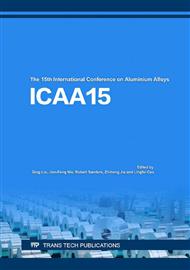p.245
p.251
p.258
p.264
p.275
p.281
p.290
p.296
p.303
Effect of Novel Thermomechanical Treatment on Microstructure and Properties of 6156 Alloy
Abstract:
A novel thermomechanical treatment (TMT) was proposed for increasing the strength of 6156 aluminum alloy while maintaining a high elongation, which is based on artificial aging at low temperature, cold rolling and natural aging. The corresponding tensile properties and microstructure of 6156 aluminium alloy under different treatments were investigated. The yield strength and the ultimate tensile strength are increased by over 50 MPa over those of T3, while a high elongation rate is maintained. The fracture mechanism of T4 and TMT state alloy are typical ductile fracture, while that of T6 and T8 state alloy is a mixture of ductile fracture and shear fracture. For the TMT processed 6156 alloy, though no obvious precipitates can be observed in the matrix, tangled dislocations around primary phase in the matrix, as well as a high density of dislocations piled up at the grain boundary were observed. The mechanism of the novel TMT, by which the mechanical properties of the alloy is greatly improved, is the synergistic effect of composite structures, including dislocation substructures, the complex of Mg-Si clusters/vacancies, as well as GP zones.
Info:
Periodical:
Pages:
275-280
Citation:
Online since:
November 2016
Authors:
Price:
Сopyright:
© 2017 Trans Tech Publications Ltd. All Rights Reserved
Share:
Citation:


